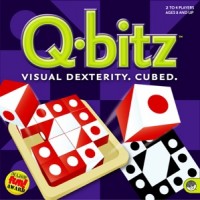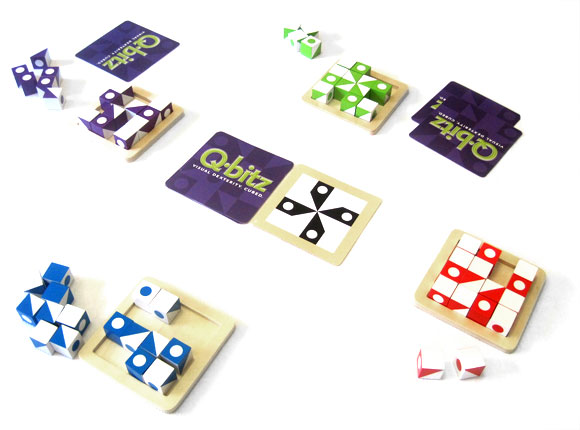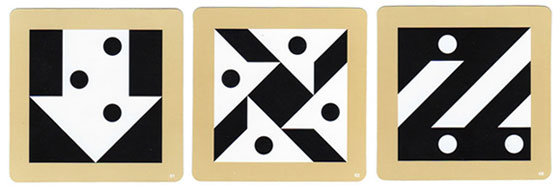
Q•bitz

Family Focus Review
These reviews provide insight on some of the best games for families with young gamers. Written from a parent’s perspective for a fun and educational family game night!
Overview
Q-bitz is a game that will have you and your children scratching your heads, biting your nails and throwing your arms up in triumph! Each player has a tray and 16 identical cubes. In each round, one of 80 different pattern cards are turned face up. Players are challenged to simultaneously recreate that pattern using their cubes on their own tray. The first player to recreate the pattern shouts: “Q-bitz!” and captures that pattern card. After nine rounds, the player with the most cards wins!
Set Up
Piece o’ cake. Players are each given a tray and a set of 16 matching cubes in one of four player colors. Each cube is identical and each has two specific matching shapes on opposite sides. (Triangles, circles and solids) . A stack of pattern cards is shuffled and placed face down in the center of the table. Players remove all the cubes from their trays to begin the game.

Gameplay
Q-bitz is played in three sets of three rounds. To begin each round, the top card is revealed from the stack of pattern cards. Players must then place the cubes into their tray, arranging the shapes exactly to duplicate that pattern on the face up card as quickly as possible. Each round has its own unique requirements:
Round 1: Dexterity!
As soon as the pattern card is revealed, all players rush to complete the pattern in any way they can. Quickly grabbing their cubes, rotating them to the proper side and placing them in the correct position in their own tray. The first player to complete the pattern shouts: “Q-bitz!” and all players must stop. If that player correctly reproduced the pattern on their own tray, they are awarded that card and round 1 ends. If that player made a mistake and did not correctly match the pattern, players may immediately resume placing blocks until one player correctly reproduces the pattern.
Round 2: Luck!
In Round 2, as soon as the pattern card is revealed, all players roll their cubes as they would dice. Then using the face up results on the cubes, rush to complete the pattern on the card in their own tray. When all possible face up cubes have been used, players grab the remaining dice and roll them repeating this step until they have rolled all shapes needed to complete the pattern. The first player to complete the pattern shouts: “Q-bitz!” and all players must stop. If that player correctly reproduced the pattern in their own tray, they are awarded that card and Round 2 ends. If that player made a mistake and did not correctly match the pattern. Players may immediately resume rolling and placing blocks until a player correctly reproduces the pattern and is awarded the card.
Round 3: Memory!
In Round 3, the pattern card is revealed to all players for 10 seconds. Players must memorize the pattern on the card in that time. Then the pattern card is turned face down and players must use their cubes to recreate that pattern on their own tray from memory. The first player who believes that have recreated the pattern accurately shouts: “Q-bitz!” and all players must stop. The player with the correct pattern wins the card. If no one reproduced the pattern exactly, then the player with the most cubes in the correct position on their tray wins the card.
Each round is played three times. At the end of the final round the player with the most cards wins the game of Q-bitz!
Components
Mindware has excellent quality components in all their games. Q-bitz is no exception. The cards are thick and durable and the trays and cubes durable and easy to manipulate. The game packs up perfectly in the box without any of the components shifting.

Learning Curve
Very easy. The game is listed for ages 8 and up and the game can be learned in a matter of minutes.
Educational Value
Q-bitz will help develop:
- Visual recognition
- Spatial relationships
- Visuospatial memory
- Manual dexterity
- Learning geometric shapes
- Process oriented thinking
For The Parent
Vastly different game experiences are possible because of the skill involved in recreating the patterns on the cards. A lot of the recommendations below are based on the fact that adults may have an unfair advantage over younger players (ages 8-10) when it comes to manual dexterity (but don’t assume that for all children!) Here are some suggestions when bringing out Q-bitz on family game night and young players (ages 8-10) are included. Remember the goal is fun!
- Keep things calm: Since the game rounds end when a player completes a pattern first, tension can rise and excitement can make things very frantic. Remind younger players that if they slow down they will make less mistakes and have more control.
- Use a Timer: In games that mix parents and much younger players, feel free to use a timer (a traditional sand timer or on your smartphone) Then award the card to the player that got the most correct cubes placed in the allotted time.
- Points play: Another way of mitigating age differences and a “pass/fail” experience is to play for points. The player to finish their pattern first gets a number of points equal to the number of players. (4 points in a four player game, etc.) The player who has the next most cubes filed in scores one less point and so on so all players score something in every round. This promotes inclusion and less of a “pass/fail” atmosphere.
- Same Round play: The rules suggest playing the same round over and over again for a simplified game. This is an excellent suggestion if younger players are not confident or enjoy playing one round type over another.
- Moderate! Finally, for games with several younger players, you as the adults may want to simply moderate a game between siblings or friends of similar age.
Final Thoughts
Q-bitz is a brain game, a multiplayer puzzle and a test of patience and perseverance.
Scared? Don’t be. Q-bitz is a game that absolutely needs to be on everyone’s family game shelf. Here’s why:
Yes it’s a brain game, but not in a way that a traditional board gamer might think. There is no strategy, no tactics, no long term planning or memory required. No inter-player wrangling or mean spirited tactics. The game tests players’ spatial recognition, immediate memory, and manual dexterity. This is an area of the brain that develops very early on and only declines when you start using a walker. In fact, studies show that by age 11 children have reached an “adult level of performance in visuospatial memory.” For the most part, this “visuospatial sketchpad” of the brain is just as developed in adults as it is in children ages 8-10. This actually provides an even playing field when it comes to the brain work in this game.
Q-bitz is a puzzle game! It challenges players to exactly recreate an 16 block pattern using three dimensional blocks that have a specific geometric shape on each side. But the game is ingeniously constructed to have each similar shape on the cube (triangles, circles and solids) on the side exactly opposite. So as a puzzle, there always is a logical and methodical solution.
First and foremost though, Q-bitz is a race! And that can really throw everything else out of whack. Working to “think” as fast as one can creates a tension filled atmosphere that can impede all the other necessary cognitive abilities.
It seems games with these three qualities might favor adults. But an amazing phenomenon happens when that pattern card is turned over. Everyone freaks out a bit and then settles down and uses their own individual abilities to problem solve. That’s the beauty of the game. It is simple to play, yet it challenges everyone in the same way simultaneously. It all comes down to how we problem solve.
Having three different round challenges makes the game diverse. In Round 1, it’s your brain against the puzzle. Round 2 adds a bit of luck in the rolling of the cubes. (Nothing beats two players rolling one cube over and over again to get that one shape that completes their pattern!). Then there’s Round 3: the memory portion of the game. In this case, younger minds may actually have an advantage over the overly cluttered minds of adults, (They did in our games in any case)! Very challenging for everyone no matter the brain size!
With over 80 patterns, the cards themselves are an integral aspect of the game. Some are symmetrical and some are not. Some are visually recognizable, (“Hey that looks like two birds!”) others look like a crazy poster from the 1970’s. So the game replay value is not only affected how much caffeine or sugar a player had before the game, or the age levels of the player but mostly in what round a pattern card pops up.
Peggy Brown has created a very smart game, easy to learn, that has you panting after each round, (or at least holding your cerebral cortex!) There are solo expansions that add two more colors (and players), an expansion pack that adds an additional 100 pattern cards, and even an “extreme” version of the game with (ugh) curved shapes. Q-bitz is a winner and an easy and enjoyable addition to any family’s game closet.
User Reviews (0)
Add a Review for "Q•bitz"
You must be logged in to add a review.

Be the First to Add a Review!